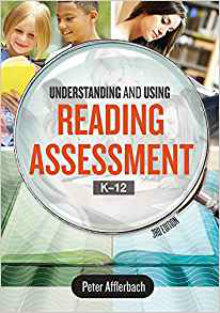Understanding & Using Reading Assessment
Understanding and Using Reading Assessment K-12
By Peter Afflerbach
(ASCD, 2017 – Learn more)
 Reviewed by Michael DiClemente
Reviewed by Michael DiClemente
The wonderful thing about teaching is that there is always more to learn. You can continue your study of your content, and you can also look into the supporting skills for your particular area.
As a middle school history teacher I have become increasingly interested in literacy skills and how I can use them to make my students’ experience more fulfilling in my classroom. I worked with the Boston Writing Project and really learned quite a bit about the writing process and how I can better incorporate writing into my classes.
I have recently been looking into reading. So much of what we do in history involves reading, and I realize that many of the students who struggle in my class are lacking reading skills. This is what led me to read and review this book.
What is being assessed?
I have always enjoyed reading, and I try to make that apparent to my students. During an entire lifetime of reading, I have never really thought about a definition of what reading is. Peter Afflerbach offers his definition early on in the book:
Reading is the act of constructing meaning from text. We use skills, strategies, and prior knowledge, all of which are developmental in nature, to understand what we read. The act of reading is supported by reader motivation and positive reader affect. We read to help us achieve our goals, within and outside of school.” (page 28)
It is imperative to have a definition of reading in order to determine what is being assessed during a reading assessment. I feel that most of us have an idea of what reading is, but I am glad the author provided his definition to help ground readers as the book moves forward.
The value of CURRV
In the context of reading assessment, and after the author has established a definition of reading, it is important to consider the suitability of a reading assessment.
Afflerbach discusses the CURRV framework (summary on page 33). CURRV stands for Consequences, Usefulness, Roles and responsibilities, Reliability, and Validity. Along with this framework to assess reading assessments, he also suggests considering the following questions regularly: “Why do we assess reading? What do we assess when we assess reading? How, where, and when do we assess reading?” (page 38) This diligence can help ensure that reading assessments are really assessing what we want them to.
I was very happy to find many history content examples used throughout the book. The book really made me think about how I was doing reading in my class and if there were ways I could be assessing reading (whether formally or informally).
One aspect of my teaching, as it relates to reading, that I really considered is how I ask questions. Am I asking the right questions the right way? “…The care we give to our question asking can contribute to students’ habits of mind and can shape and expand their thinking.” (page 102) Quite a heavy statement for those of us in the classroom with reading students, but I welcome the challenge.
Reading in all content areas
Even if the flat-sounding title turns you off a little – or if you don’t feel like you need to know about reading assessment – I think that Afflerbach’s book can teach you about the importance of reading in all content areas.
The book offers many strategies and even (at the end) gives strategies to promote self-assessment in students. If, as educators, we can give students choice and promote a love of reading, so many doors will be open for these children as they grow older (please pardon the cliche but it seemed most fitting).
I would like to end on this great quote from the book (page 197):
Aliteracy may be explained not by a failure to learn to read but by a failure to realize the full value of reading.”
_______________________
Michael DiClemente is a sixth grade Ancient Civilizations teacher in Medford, MA. He also advises the the Middle School Model UN Club and runs the eighth grade trip to New York City. DiClemente has taken on the responsibility of New Teacher Liaison in his district, which is a new position. In this position he seeks to better welcome and support new teachers.




































It would help immensely if all teachers were required to take a reading methods course to get their credential. Also, I hope this book has at least one chapter on strategies to use with English Language Learners and the “remedial” reader. Too many times only the English teacher (especially in secondary) differentiates or applies reading strategies. All teachers need to be reading teachers.